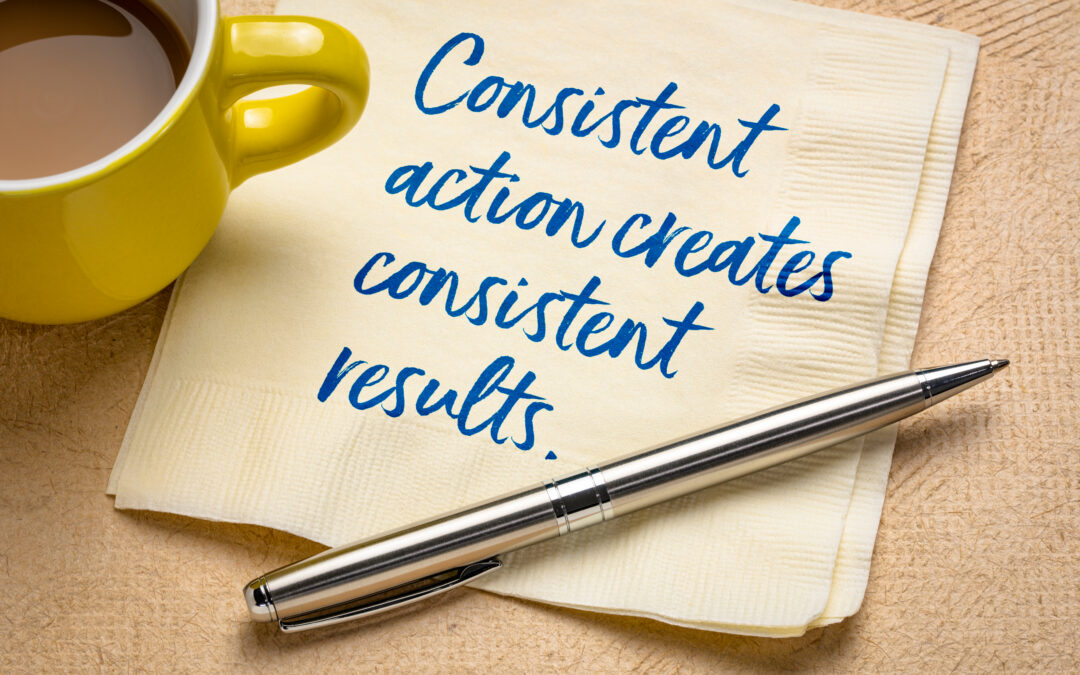Consistency: the ability to replicate a process or activity with the same level or quality over and over again. That’s the definition. And, that’s everything if someone want to find success.
Regardless of one’s health goals, and the steps they take to achieve them, being consistent is what it takes for long-term success.
Why is consistency so hard?
Consistency is (may be) hard because:
- our world often promises quick fixes & frustration occurs when things don’t happen fast enough
- our bar is too high and goals feel overwhelming to conquer
- goals aren’t enjoyable
- the strategy wasn’t matched to our personality type
- INSERT YOURS
The research on healthy habits and habit formation is robust. A few of my favorites:
- Atomic Habits by James Clear
- Better Than Before by Gretchen Rubin
- The Four Tendencies by Gretchen Rubin
- Tiny Habits by BJ Fogg
When I work with clients, we establish strategies they want to take to support their goals. The next step, however, is the most important. How do we ensure the steps they want to take can be consistently practiced?
How to be Consistent:
Step 1: Keep it easy.
Why easy? Because the chances you’ll find success are high. Success breeds success. Easy steps may not feel grandiose. They may feel like it will take too much time to reach your goal. But, they will lead to consistency. For example, my client who wanted to increase fiber in his diet added 2 T of seeds to his daily yogurt. What if I had told him to go from eating 5 servings of veg to 10? While 10 servings might be ideal, the goal was too much of a change. A change he would likely drop after a few weeks.
Step 2: Make it enjoyable.
What’s the point of improving your health if you resent the actions to get there? Most people don’t keep an account on My Fitness Pal because they don’t “enjoy” it. It feels like work. In BJ Fogg’s book, he discusses 3 questions to ask yourself when setting a healthy habit to reach a goal.
- Is it easy?
- Is it something you’d look forward to?
- Would it help you reach your larger goal?
Back to the guy who wanted to increase fiber in his day:
- adding pumpkin seeds to his yogurt is easy
- he likes the crunch in his yogurt
- it adds 3 grams of fiber to his snack (goal achievement)
Step 3: Make sure the goal strategy fits YOU
Not everyone responds to the same strategy when it comes to consistency. Some people, when they set a goal, have such intrinsic drive that they don’t need anyone to check in on them. Others, thrive when they an accountability partner. Routines work for some. Others thrive on spontaneity. Back to our fiber friend, the spontaneous client might need 5 different types of high-fiber foods to add to their yogurt. Habit researcher, Gretchen Rubin, has a free online quiz to assess what works best for you when it comes to habit formation.
Step 4: Pay attention
More recently, I’ve increased my intake of leafy greens and cruciferous vegetables. I was inspired to do so after giving a corporate wellness seminar on the health benefits of plants. These plants contain an incredible detoxifying compound that benefit health in many ways. I started noticing that my heavier plant-rich diet made me feel better. I had a bit more energy, I felt lighter after meals, and my digestion was on point. Noticing these feelings encouraged me to keep my habit going.
As humans, we tend to notice the “bad.” We tend to pay attention when something isn’t right. To be fair, improvements in health are often quieter. They require you to pay closer attention. But, pay attention to how you feel after engaging in your healthy habits. Listen to your body, your mental chatter, your mood, your energy…
The subtle improvements have the potential for louder positive outcomes.
Step 5: Have grace
Grace, self-compassion, understanding feels so much better than guilt, critique, or disgust. Black and white thinking or all-or-nothing thinking tends to set one up for feelings of failure. You cannot and will not be perfect. Can you expect you won’t get it “right” everyday? People who can offer themselves grace or speak to themselves in a compassionate way have more success. Yes, that flies in the face of what you might think you need: willpower, determination, being hard on yourself to reach success. Research confirms it. When you expect you won’t be perfect. When you’re nice to yourself if you don’t get it right – you’re more likely to let it go and continue moving forward.
Each of the 5 steps is welcoming. They’re an invitation to be curious and learn more about ourselves. And, they build to a strong foundation of success when it comes to being consistent.

